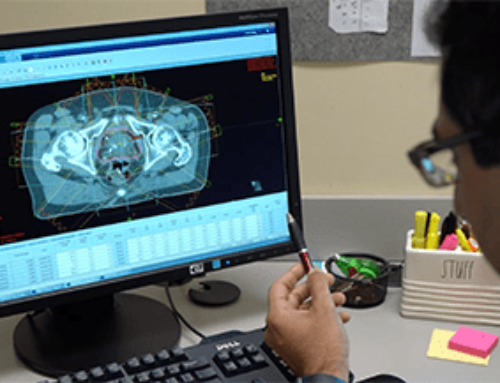The diagnosis and treatment of cancer can be a life-changing event for patients, their families, and friends. Along with physical, mental, and emotional challenges, this difficult time often includes periods of high stress, anxiety, and uncertainty. Having the right information and getting essential questions answered can go a long way toward easing the situation.
“A lot of times we get questions from patients regarding how long their treatment will be and how frequently they will be coming in,” says Richard J. Lee, M.D., radiation oncologist at Central Florida Cancer Care Center. “In general, when we talk about radiation treatment, the length and frequency of treatment depend on why we’re treating the patient.”
What is Radiation Therapy?
Radiation therapy is a form of cancer therapy that employs high-intensity wave energy to destroy cancer cells. Over 50% of cancer patients receive radiation therapy as part of their treatment protocol. X-rays are the most common type of energy used during treatment, but gamma rays, protons, or electron beams can also be utilized. Radiation therapy refers typically to external beam radiation, meaning the source of energy comes from a device outside the patient’s body, targeting the beams at a specific location on the body.
However, radiation therapy can also be administered in other ways. Internal radiation therapy, known as brachytherapy, refers to the placement of a radioactive implant inside the body near the tumor location. The implant capsule can carry a higher dose of radiation to treat a smaller area than would be possible with external beam radiation.
Another form of radiation treatment, known as systemic radiation therapy, uses radioactive materials administered orally or through a vein. Although the radiation does pass through the body, the vast majority will be released at the tumor site, posing minimal risk to the rest of the body.
The proliferation of cancer cells inside the body stems from the fact that cancer cells divide and spread more rapidly than healthy cells. Radiation beams make tiny cracks in the DNA inside cancerous cells causing them to die. The goal of radiation therapy is to impact and destroy only malignant cells. However, healthy cells may also get damaged in the process. Most normal cells can recover and return to normal functioning within a short time.
What is Radiation Therapy Used For?
Radiation therapy is used to treat an array of cancers, either alone or in conjunction with other cancer treatments such as surgery or chemotherapy. A radiation oncologist will use radiation therapy to treat or cure early-stage cancer and to prevent cancer from returning to another area of the body. Radiation therapy may be used for palliative care, with the goal to alleviate the symptoms and suffering caused by advanced-stage cancer.

Dr. Lee notes that depending on the type of cancer and the treatment plan involved, the time and regularity of radiation therapy may vary. “A palliative track, a short course to improve symptoms, or a definitive treatment to cure the cancer may all have differing time lengths and visit frequencies,” he says.
How Long Will My Radiation Treatment Last?
Generally speaking, the radiation required to destroy a tumor cannot be administered all at the same time; it would pose a high risk to healthy tissue cells and increase the likelihood of potential adverse side effects. Spreading the dosage out over many treatments, called fractions, can help preserve the health and integrity of regular cells and lower the risk and severity of side effects.
In most cases, treatments are administered daily on an outpatient basis for up to nine weeks, excluding weekends, giving patients time to rest and allowing normal cell tissues to recuperate. The total dose of radiation and the frequency of treatment is determined by:
- The size and location of the tumor
- The type of cancer
- The goal of therapy
- A patient’s overall health and medical history
- Other types of treatment being followed by the patient
“Typically, external radiation treatment would range from about two weeks to up to nine weeks of daily treatment, Monday through Friday, five days a week,” says Dr. Lee. “The treatment generally lasts about 10-15 minutes with the machine on, but we usually recommend about 20-30 minutes per visit to allow time for checking in, getting queued to the machine, and making sure that you’re lined up perfectly to the machine before treatment.”
In some cases, different radiation therapy schedules may be applied. If the goal is to alleviate symptoms (when the total dose of radiation is lower than usual), radiation might only be administered for up to three weeks. In other circumstances, a patient may receive radiation therapy twice or more daily for a specified period. Patients may also be given a few weeks off between treatments so their body can heal while the tumor withers.
A radiation oncologist will help plan and determine the best treatment strategy available for the patient’s unique circumstances.





